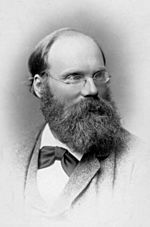Albert Heim facts for kids
Quick facts for kids
Albert Heim
|
|
|---|---|

Albert Heim
|
|
| Born | 12 April 1849 |
| Died | 31 August 1937 (aged 88) |
| Nationality | Swiss |
| Awards | Wollaston Medal (1904) Marcel Benoist Prize (1923) Foreign Member of the Royal Society |
| Scientific career | |
| Fields | geology |
| Influenced | Charles Lapworth; Richard Fortey |
Albert Heim (born April 12, 1849 – died August 31, 1937) was a famous Swiss geologist. He was best known for his important three-volume book, Geologie der Schweiz (Geology of Switzerland).
Contents
A Young Geologist's Start
Albert Heim was born in Zürich, Switzerland. From a young age, he was fascinated by the Alps mountains. When he was just 16, he built a detailed model of the Tödi mountain group.
This model caught the eye of Arnold Escher von der Linth, another well-known geologist. Escher encouraged Heim and taught him a lot about geology in the field. Heim later studied at the universities of Zürich and Berlin.
Career and Family Life
In 1873, Albert Heim became a professor of geology at the polytechnic school in Zürich. Two years later, in 1875, he also became a geology professor at the university. That same year, he married Marie Heim-Vögtlin. She was a very important person in Swiss history, as she was Switzerland's first woman doctor!
In 1882, Heim was chosen to be the director of the Geological Survey of Switzerland. This meant he was in charge of mapping and studying the country's geology. In 1884, he received an honorary PhD degree from the University of Berne.
Uncovering Mountain Secrets
Albert Heim was especially famous for his studies of the Alps. He helped us understand how huge mountain ranges are formed. He showed how rocks can bend and fold, creating amazing shapes. He also explained how large sections of rock can slide over others, a process called overthrust faulting.
His book, Mechanismus der Gebirgsbildung (which means Mechanism of Mountain Building), published in 1878, is still considered a classic today. It even inspired other geologists, like Professor C. Lapworth, in their studies of the Scottish Highlands. Heim also spent a lot of time studying glaciers in the Alps.
His important work earned him many awards. In 1904, he received the Wollaston medal from the Geological Society of London. The next year, he became a member of the Royal Swedish Academy of Sciences.
Heim's Legacy
Albert Heim's name lives on in science. A special measurement for how pyroclastic flows (fast-moving hot gas and rock from volcanoes) and avalanches move is called the Heim coefficient. There's even a ridge on the Moon named Dorsum Heim after him!
Saving a Dog Breed
Albert Heim wasn't just a geologist; he also loved dogs! In 1908, he met Franz Schertenlieb, who showed him two short-haired Bernese Mountain Dogs. Heim realized these dogs were special. They were part of an old, large mountain dog breed that was almost gone. These dogs had been used for guarding, pulling carts, and herding cattle across Europe for a long time.
Heim was an expert on Sennenhund dogs (Swiss mountain dogs). He encouraged people to breed these dogs again. Thanks to his efforts, this breed was saved! In 1909, the Swiss Kennel Club officially recognized them as a separate breed called "Grosser Schweizer Sennenhund" (Greater Swiss Mountain Dog). A special club was formed in 1912 to help promote them.
The Bernese Mountain Dog and the Greater Swiss Mountain Dog are two of four unique Swiss farm dog breeds. They were saved from disappearing by people like Schertenlieb and Heim in the late 1800s.

